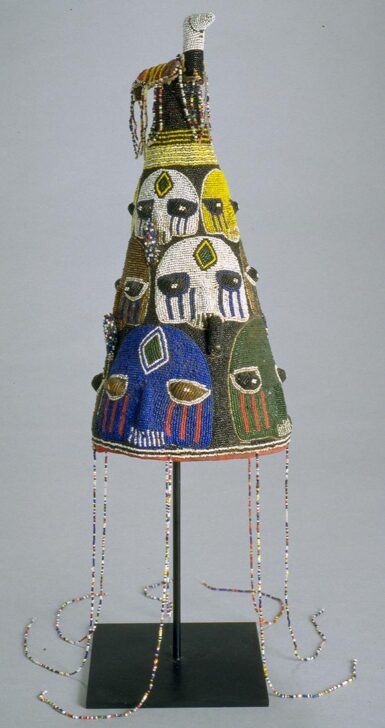Oba’s Beaded Crown
Yoruba

Description
March 28, 2009
When a Yoruba ruler, or oba, places an adénlá such as this on his head, it is a ritual act of becoming one with his ancestors and the deities. The beaded fringe is designed to protect onlookers from the supercharged spiritual intensity of the ruler’s gaze, while the penetrating eyes of the orisa and ancestors are meant to scan the world to protect the ruler’s “inner” head from external threats. The bird perched atop this adénlá represents a powerful association with elderly women whose secret knowledge can sustain or destroy a person’s potential. Obas respect the authority of these elders in order to maintain a healthy kingdom. A medicine pack stored in the crown’s inner peak is believed to contain powerful levels of àse, or life force.
Subject Matter:
The great crown, known as adénlá in the Yoruba language, would have formed the centerpiece of the regalia of an oba, a sacred king that could trace his ancestry to Oduduwa, the founder and first oba of Yoruba peoples. Always in a conical shape with motifs of birds and frontal faces with a beaded, fringed veil (iboju), the adénlá was the main symbol of an oba’s authority. The conical shape of the adénlá reflects the ori inu, the inner head or personal destiny, of the oba; it was a visible symbol of his spiritual power. As the oba was incredibly powerful while wearing the crown, the beaded veil was necessary to protect people who looked upon him from a god-like gaze. The veil’s concealment increased the spirituality surrounding the oba, as it was a way to convey the divine qualities of the oba. The veil also masked the individual, so the focus was on the oba’s role as leader of the community. The faces on the crown may have represented past rulers, or allowed the oba to see and know everything that happened in his kingdom. On the outside of the crown, the beadwork was a sign of wealth and status, reserved for royals and religious leaders. Seed beads were introduced in the 19th century by European traders; the many colors allowed craftsmen to create patterns that showed the authority of the oba. The inside of the adénlá was significant as well. A herbalist priest prepared the crown by placing a packet of herbal medicines in the top. However, it was not an adénlá until placed on the head of the oba from behind by a senior woman, signifying that an oba could not rule without the support of women. The birds on the crown referred to this, as they were as symbol of the mystical power of women, known as awon iya wa, “our mothers.”
Drewal, H., Yoruba: Nine Centuries of African Art and Thought, 1989
Pemberton, J., African Beaded Art: Power and Adornment, 2008
Thompson, R.F., The Sign of the Divine King: An Essay on Yoruba Bead-Embroidered Crowns with Veil and Bird Decorations, African Arts Vol. 3: No. 3, 1970
Doris, D. Yoruba Images and Aesthetics, 2004
Physical Description:
Conical shaped crown with multi-colored beadwork and a beaded fringe veil. From the bottom of the crown moving up, there are three rows of four faces, where the opposing faces have the same color. On the bottom, 2 faces are blue and 2 are green; the next row has 2 white and 2 brown faces; the top row has 2 white and two yellow faces. The red beads on the faces may resemble scarification marks. There are three-dimensional birds along the sides of the crown as well as a large one on top that is removable. 7 strings of multi-colored beads hang from the crown; most of the beaded veil is missing.
Usage Rights:
If you are interested in using an image for a publication, please visit https://umma.umich.edu/request-image/ for more information and to fill out the online Image Rights and Reproductions Request Form.